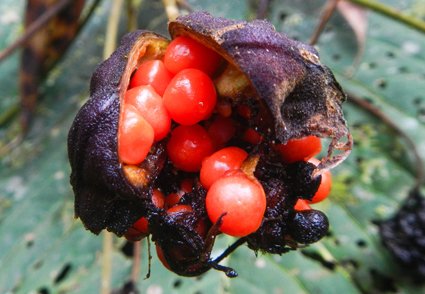Abstract
Bomarea quitensis, a new endemic species from Pichincha Province, is described. Due to its long pedicels (11.0–12.5 cm), this new species belongs to B. subgenus Bomarea. Bomarea quitensis is related to B. longipes and B. crinita but differs from these species in leaf shape and size, number of flowers and colour of the sepals. Photos of all its structures and a distribution map are presented; additionally, the conservation status of B. quitensis is assessed.
References
- Alzate, F., Mort, M.E. & Ramirez, M. (2008) Phylogenetic analyses of Bomarea (Alstroemeriaceae) based on combined analyses of nrDNA ITS, psbA-trnH, rpoB-trnC and matK sequences. Taxon 57: 853–862. https://doi.org/10.1002/tax.573014
- Baker, J.G. (1882) On a collection of bomareas made by M.E. André in New Grenada and Ecuador. Journal of Botany, British and Foreign 20: 201–206.
- Clark, J.L., Fierro-Minda, A., Exe, N., Johnson, M., Tribble, C.M. & Jost, L. (2023) Bomarea pastazensis (Alstroemeriaceae), an exceptionally small new species from the eastern Andean slopes of Ecuador. PhytoKeys 235: 31–42. https://doi.org/10.3897/phytokeys.235.110525
- Dumortier, B.C. (1829) Analyse des familles des plantes. Casterman, Aîne, Tournay. 112 pp.
- Harling, G.W. & Neuendorf, M. (2003) Alstroemeriaceae. Flora of Ecuador 71. In: Harling, G.W. & Andersson, L. (Eds.) Flora of Ecuador. University of Göteborg, Sweden, pp. 3–108.
- Herbert, W. (1837) Amaryllidaceae: preceded by an attempt to arrange the monocotyledonous orders, and followed by a treatise on cross-bred vegetables, and supplement. Ridgway, London, 546 pp. https://doi.org/10.5962/bhl.title.116651
- Hofreiter, A. & Lyshede, O.B. (2006) Functional leaf anatomy of Bomarea Mirb. (Alstroemeriaceae). Botanical Journal of the Linnean Society 152: 73–90. https://doi. org/10.1111/j.1095-8339.2006.00540.x
- Hofreiter, A. & Tillich, H.J. (2002) The delimitation, ecology, distribution and infrageneric subdivision of Bomarea Mirbel (Alstroemeriaceae). Feddes Repertorium 113: 528–544. https://doi.org/10.1002/fedr.200290005
- Hofreiter, A. (2008) A revision of Bomarea subgenus Bomarea s.str. section Multiflorae (Alstroemeriaceae). Systematic Botany 33: 661–684. https://doi.org/10.1600/036364408786500172
- IUCN Standards and Petitions Committee. (2024) Guidelines for using the IUCN Red List categories and criteria, version 16. Prepared by the Standards and Petitions Committee. Available from: http://www.iucnredlist.org/documents/RedListGuidelines.pdf (accessed 9 April 2024).
- Killip, E.P. (1936) Bomarea Mirb. In: Macbride, J.F. (Ed.) Flora of Peru. Part I. Publication of Field Museum of Natural History, Botany Series 13: 633–665.
- Ministerio del Ambiente del Ecuador (2013) Sistema de clasificación de los ecosistemas del Ecuador continental. Subsecretaria de Patrimonio Natural, Quito, 232 pp.
- Ministerio del Ambiente del Ecuador (2017) Deforestación del Ecuador continental periodo 2014–2016. Quito, Ecuador.
- Mirbel, C.F.B. (1804) Les bomares, Bomarea. In: Buffon, G.L.L. (Ed.) Histoire naturelle, génerale et particulière des plantes 9. Didot, Paris, pp. 71–72.
- Mittermeier, R.A., Turner, W.R., Larsen, F.W., Brooks, T.M. & Gascon, C. (2011) Global biodiversity conservation: the critical role of hotspots. In: Zachos, F.E. & Habel, J.C. (Eds.) Biodiversity hotspots. Springer, Berlin, Heidelberg, pp. 3–22. https://doi.org/10.1007/978-3-642-20992-5_1
- Myers, N., Mittermeier, R.A., Mittermeier, C.G., da Fonseca, G.A.B. & Kent, J. (2000) Biodiversity hotspots for conservation priorities. Nature 403: 853–858. https://doi.org/10.1038/35002501
- Neuendorf, M. (1977) Pardinae, a new section of Bomarea (Alstromeriaceae). Botaniska Notiser 130: 55–60.
- Pérez, Á.J., Arroyo, F., Neill, D.A. & Vázquez-García, J.A. (2016) Magnolia chiguila and M. mashpi (Magnoliaceae): two new species and a new subsection (Chocotalauma, sect. Talauma) from the Chocó biogeographic region of Colombia and Ecuador. Phytotaxa 286: 267–276. https://doi.org/10.11646/phytotaxa.286.4.5
- Thiers, B. (Ed.) (2017) Index herbariorum. New York Botanical Garden’s Virtual Herbarium. Available from: http://sweetgum.nybg.org/science/ih/ (accessed 5 January 2024).
- Tribble, C.M., Alzate-Guarín, F., Gándara, E., Vartoumian, A., Burleigh, J.G., Zenil-Ferguson, R., Specht, C.D. & Rothfels, C.J. (2023) The rapid radiation of Bomarea (Alstroemeriaceae: Liliales), driven by the rise of the Andes. Evolution 78: 221–236. https://doi.org/10.1093/evolut/qpad184


